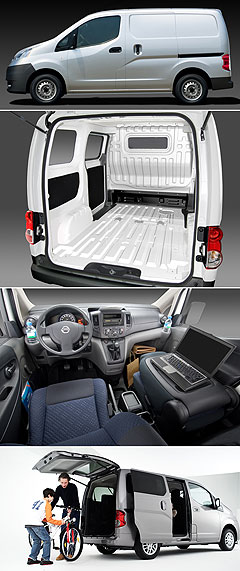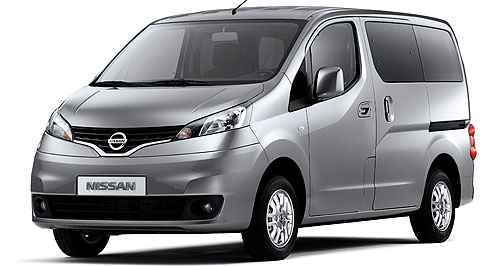Make / Model Search
Future models - Nissan - NV200Nissan vans edge closerDouble duty: Nissan's small NV200 is one of two vans headed to Australia to take on the hotly contested load-hauler market. The Nissan NV200 and a rival for Toyota HiAce earmarked for Australia7 Mar 2010 ONE year on from its Geneva motor show debut, Nissan’s NV200 small van is still on track for an Australian launch sometime within the next 12 to 24 months, although Nissan will not publicly commit to a definite date. It will form part of a two-pronged van attack by the Japanese company that should also include an as-yet unrevealed competitor to the Toyota HiAce, Hyundai iLoad and Volkswagen Transporter ranges. According to Nissan Australia managing director and CEO Dan Thompson, both vans will be strong on value. But Nissan will not get into a price war or discounting, since the vans will feature class-leading levels of driveability, comfort, safety and practicality. In fact, it appears that the Australian arm has held off importing the existing range of Nissan vans to have the latest and the best on hand as it strives to increase overall market share from under six per cent last year to around 10 per cent at the end of 2012. Making the van business profitable for itself and dealers is also a top priority for Nissan.  “There’s been a lot of investment in Nissan’s global van strategy,” Mr Thompson told GoAuto. “There are lots of good opportunities in the small-van space as far as what Nissan is doing. Vans are the other global products that we are looking at. “But while the total van market is about 25,000 (units a year) we’re not looking to find one thousand sales a month out of our van strategy – it’s more like 200 to 300 units. So we just have to make sure it works well, and it definitely works well from a brand perspective and strength. “Our fleet strategies will become a lot more important once we get into our growth stage for us in 2011 and 2012. “There is a demand, there is a need for vans, and there has been tremendous progress over the last two years within Nissan and vans, so we are very excited about what’s developing and what’s coming and the options are quite significant that weren’t there before. “And when we eventually do bring in vans they will be competitive vans.” Mr Thompson said the Korean manufacturers had helped to make the van segment hotly contested. “We just want to get it right, and we are not going to try and come in and own a value proposition – that’s not our objective,” he said. “We want to bring in a competitive class-leading product that is profitable.” As we reported back in April last year, the NV200 is a Volkswagen Caddy-sized small van that Nissan claims has been designed from the onset to be both a load carrier and a people-mover. Aiding its workhorse persona, it includes sliding side doors and a pair of rear barn doors, 4.1 cubic metres of loading space and a two-metre load area within a total overall length of just under 4.4m (to make the NV200 “the largest load space in its class” according to Nissan), and a maximum payload of 771kg. There is also a low floor, a roof height of 1.84 metres, and a front passenger seat that can be folded forward for longer objects. It is built on a variation of the front-wheel drive Alliance B-platform as seen in the Micra, Tiida and Renault Clio in Australia, and features MacPherson strut front suspension mounted on a separate sub-frame, and a compact leaf-sprung rear axle. Engine choices for Europe include a 79kW/153Nm 1.6-litre four-cylinder petrol mated to a five-speed manual gearbox, or a Renault-sourced 63kW/200Nm 1.5-litre dCi four-cylinder turbo-diesel unit allied to a five-speed automated transmission. The NV200’s predecessor, the Vanette, was sold in Australia as the Datsun C20 forward control rear-drive van from 1980 to 1982, and then as a broad range of Vanette models of similar mechanical configuration until 1993. These included six-seater GL and eight-seater SGL people movers until the mid-1980s, as well as the rebodied C22 versions from 1987 onwards. Meanwhile, on the larger van front, the Datsun/Nissan E20, E22 and E23 Urvan were sold in various formats Down Under until 1993, although the Homer nameplate was used on earlier iterations, employing a single carb version of the Fairlady sports car’s 1.5-litre four-cylinder engine.  Read moreAll future models Alfa Romeo Alfa Romeo Abarth Abarth Alpine Alpine Alpina Alpina Audi Audi Aston Martin Aston Martin BMW BMW Bentley Bentley Chery Chery Brabham Brabham Chrysler Chrysler Chevrolet Chevrolet Cupra Cupra Citroen Citroen DS DS Dodge Dodge Fiat Fiat Ferrari Ferrari Foton Foton Ford Ford Great Wall Great Wall FPV FPV Haval Haval GWM GWM Honda Honda Holden Holden Hummer Hummer HSV HSV Infiniti Infiniti Hyundai Hyundai Jaguar Jaguar Isuzu Isuzu Kia Kia Jeep Jeep Land Rover Land Rover Lamborghini Lamborghini Lexus Lexus LDV LDV Mahindra Mahindra Lotus Lotus Mazda Mazda Maserati Maserati Mercedes-AMG Mercedes-AMG McLaren McLaren MG MG Mercedes-Benz Mercedes-Benz Mitsubishi Mitsubishi Mini Mini Opel Opel Nissan Nissan Peugeot Peugeot Pagani Pagani Proton Proton Porsche Porsche Renault Renault Ram Ram Rover Rover Rolls-Royce Rolls-Royce Skoda Skoda Saab Saab SsangYong SsangYong Smart Smart Suzuki Suzuki Subaru Subaru Toyota Toyota Tesla Tesla Volvo VolvoMotor industry news |
Click to shareNissan modelsResearch Nissan All future models Alfa Romeo Alfa Romeo Abarth Abarth Alpine Alpine Alpina Alpina Audi Audi Aston Martin Aston Martin BMW BMW Bentley Bentley Chery Chery Brabham Brabham Chrysler Chrysler Chevrolet Chevrolet Cupra Cupra Citroen Citroen DS DS Dodge Dodge Fiat Fiat Ferrari Ferrari Foton Foton Ford Ford Great Wall Great Wall FPV FPV Haval Haval GWM GWM Honda Honda Holden Holden Hummer Hummer HSV HSV Infiniti Infiniti Hyundai Hyundai Jaguar Jaguar Isuzu Isuzu Kia Kia Jeep Jeep Land Rover Land Rover Lamborghini Lamborghini Lexus Lexus LDV LDV Mahindra Mahindra Lotus Lotus Mazda Mazda Maserati Maserati Mercedes-AMG Mercedes-AMG McLaren McLaren MG MG Mercedes-Benz Mercedes-Benz Mitsubishi Mitsubishi Mini Mini Opel Opel Nissan Nissan Peugeot Peugeot Pagani Pagani Proton Proton Porsche Porsche Renault Renault Ram Ram Rover Rover Rolls-Royce Rolls-Royce Skoda Skoda Saab Saab SsangYong SsangYong Smart Smart Suzuki Suzuki Subaru Subaru Toyota Toyota Tesla Tesla Volvo VolvoMotor industry news |










Facebook Twitter Instagram